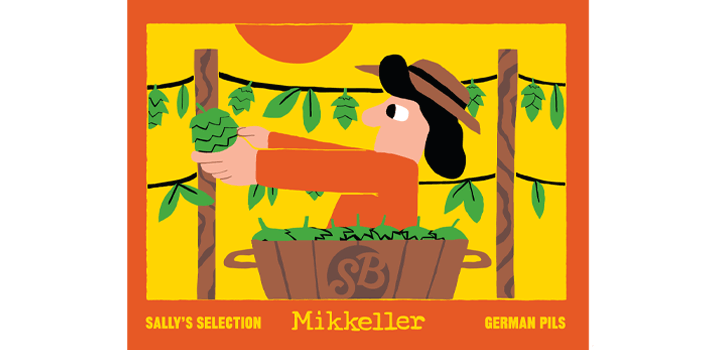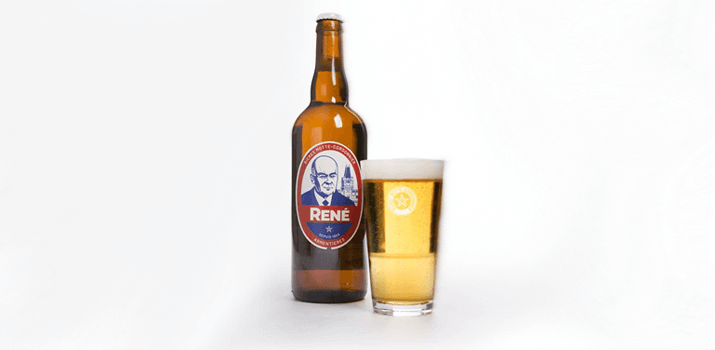Bottom of the Bottle
Last week we discussed proper storage for specific styles of beer: which temperatures are the most suitable and which ones are best for aging. We also touched on a couple of things to consider--storing upright, in the dark, etc.--but let's dig a little deeper to find out why.
Bottle Conditioned
Storing bottles upright is a best practice especially if a beer is bottle-conditioned. Bottle-conditioning is a secondary fermentation process that creates CO2--carbonation--in the bottle. Additional sugars are desposited into the bottle in a process called priming. The beer is left unfiltered and the residual yeast in suspension will continue to work on the extra sugars and, in turn, give off a natural carbonation. Extra yeast can be added in certain circumstances as well. Ultimately the yeast will fall out of suspension and collect on the bottom of the bottle. If the bottle is stored on its side the sediment will collect on the side and eventually end up in your glass. Some people like this but the beer sure doesn't look pretty!
Brown Bottles
Brown glass is the only glass that can filter out to some degree the UV rays that come from the sun (and flourescent lighting). Some breweries insist on packaging their beer in clear or green bottles. While this may work for their branding purposes these beers are highly susceptible to getting lightstruck. A lightstruck beer tastes like skunk or similar to burnt rubber and old onions. This occurs because of a chemical reaction that takes place when UV light breaks down the isohumolones from the hops. Obviously removing the UV rays from the equation is easier than hops so that's why it's advised to purchase beer in brown bottles. If that's not possible (or you just gotta have that lager in a green bottle) make sure to store it away from light sources, in the dark or behind UV filtered glass. You could also stick it in a carrier with tall walls.
Oxidation
Oxidation can happen to most beers at various steps along the brewing process by introducing oxygen. Much like light, oxygen is an enemy to beer. While it's nearly impossible to keep out all oxygen from a bottle, higher temperatures can surely speed up the process and leave you with beer that tastes stale, like wet cardboard, paper and sherry (which is only a good thing in a few styles). It doesn't matter if your bottle is corked, has a crown cap or covered in that fancy foil--microscopic holes allow enough oxygen in over time to kill your beer. Cool and cold temperatures will preserve the life of the beer by virtually stopping oxidation and that's why it's important to store your beer for the requisite amount of time and at appropriate temperatures.
Bottle conditioned beers give natural carbonation but should be stored upright.Brown glass keeps out UV rays and prevents beers from getting "skunked".
Consistent cooler temperatures help slow down or prevent oxidation
Pretty Presentation
Just a quick thought on bottled beer: While canned beer has its many benefits, the one thing it falls short on is presentation. Bottled beer comes in many shapes and sizes--many of which look fantastic on the dinner table or as a quality gift. These days much care is put into a bottle’s design. There should be no reason why, if there’s space, a beautiful bottle can’t sit proudly on the table. Beer is widely available in 750ml bottles—which are perfect for sharing—and often sealed with champagne corks, foil or wax seals and wire cages. While many brewery labels won’t have you reminiscing about your last trip to the Bourgogne, they are nevertheless fashionably designed and worthy to be admired. Double-check, however, to make sure that a beer name like Shart Pants or Snozzberries (actual beer names) aren’t hidden behind curly writing. Unless your friends have that sort of humour.
The Can Can
While beer has historically been packaged in bottles of all shapes and sizes, canned beer has come a long way in terms of quality. Technological advances means that the days of a metallic "can' taste leeching into the beer are long gone. Instead, cans can ensure freshness in ways better than a bottle could. While that's not saying bottles should be replaced--because beer has managed to get along ok for centuries in them--let's discuss some of the benefits of beer in a can.
Air Tight
Those issues above about oxidation are virtually nil in a can. When packaged correctly at the brewery (it's not as simple as filling it up; oxygen cannot seep into the can!) having the beer come into contact with oxygen is nearly impossible. You're still going to want to store canned beer at correct temperatures and for less time than it's going to take Neptune to orbit the sun but one of the benefits of beer in cans is its air-tightness.
Opacity
Same goes for light: since a can is opaque, it can't get in. And you can't end up with a lightstruck, skunky beer without exposing it to light. So go ahead and buy all the green-canned beers you like. Unless it was really exposed to an actual skunk, it should taste as fresh as the brewer made it.
Quick to Chill
Aluminium is used in many applications, including canned beer, because of its high thermal conductivity. Thus, beer in cans chills much quicker and more consistently than bottled beer. Unfortunately, the opposite is true too: it'll take on heat pretty fast. Therefore it is important to keep canned beer at constant lower temperatures because too much fluctuation can impact a beer's quality. But hey--enjoying a beer without delay is definitely a benefit in our book!
When packaged properly, canned beer is impermeable to oxygen.
Since cans are opaque, you can't get a lightstruck beer in a can.
Aluminium cans allow beer in a can to come to the desired temperature more quickly.
Rack 'em and Stack 'em
Finally, one of the other benefits of canned beer over bottles is that they're so much easier to store and carry. Its universal shape means that you're able to store much more, much easier in your cellar as opposed to bottles. Furthermore, the lighter packaging of aluminium makes them much more portable and since they're not glass they're much more durable. Have you ever tried clinking and clanging your way to a picnic with a couple dozen bottles of beer in your rucksack? Well, don't do it again. Reach for the can!
Thanks a lot for reading along with us again this week. We hope you've learned a good bit about the benefits of canned beer and how to best take care of your bottled stuff. We'll see you again next week when we'll get into a couple of the world's favourite beer styles: the American IPA and the Munich Helles Lager. Perhaps grab an Augustiner Helles and a Stone IPA. This will be a review tasting session before we get to the review and then the QUIZ...ba ba baaaaaaaa.





